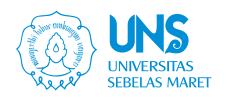Analisis self-efficacy pada peserta didik di sekolah dasar se-kota surakarta
Abstract
Abstract. This study aims to describe the self-efficacy of students in elementary schools in city of surakarta. The research method used is descriptive quantitative with a sample of 178 students from grades III and IV at SD Negeri Danukusuman, SD Negeri Manahan, and SD Negeri Munggung, selected using purposive sampling techniques. Data collection used a non-test method in the form of self-assessment. The instruments used have three dimensions, namely the level dimension, generality dimension, and strength dimension. The results show that the self-efficacy of students in the very good category consists of 15 students with a percentage of 8.45%, the good category consists of 89 students with a percentage of 50%, the sufficient category consists of 56 students with a percentage of 31.45%, and the inadequate category consists of 18 students with a percentage of 10.1%. All dimensions, namely the level dimension, generality dimension, and strength dimension, are categorized as good.
Keywords
References
Sevinka, A. Y., Dantes, N., & Putri, D. A. W. M. (2023). Pengembangan Instrumen Skala General Self-Efficacy pada Siswa Sekolah Menengah Pertama. Jurnal EDUCATIO: Jurnal Pendidikan Indonesia, 9(1), 410. https://doi.org/10.29210/1202323097
Bandura, A. (1998). Self-Efficacy: The Exercise of Control. W.H. Freeman and Company.
Putri, R. A., & Awalludin, S. A. (2024). Analisis Kemampuan Berpikir Kreatif Matematis Ditinjau dari Self Efficacy dalam Menyelesaikan Soal Berbasis Literasi dan Numerasi. FIBONACCI : Jurnal Pendidikan Matematika, 10(1), 51–64. https://jurnal.umj.ac.id/index.php/fbc/article/view/21758/10520
Yulita, R., & Defrinal. (2025). Peranan Self Efficacy dalam Meningkatkan Minat Belajar. Journal of Learning and Teaching, 02(01), 9–15.
Ferdyansyah, A., Rohaeti, E. E., & Suherman, M. M. (2020). Gambaran Self Efficacy Siswa Terhadap Pembelajaran. FOKUS (Kajian Bimbingan & Konseling Dalam Pendidikan), 3(1), 16. https://doi.org/10.22460/fokus.v3i1.4214
Iklima, I., Marzal, J., & Damris, M. (2016). Pengaruh Model Pembelajaran Kooperatif Tipe Team Assisted Individualization dan Self-Efficacy terhadap Kemampuan Pemecahan Masalah Fisika Siswa di MTs N Kota Jambi. Edu-Sains, 5(1).
Bandura, A. (1998). Self-Efficacy: The Exercise of Control. W.H. Freeman and Company
Herlina, E., Suprapto, P. ., Badriah, L., & Hernawati, D. (2025). Potret Awal Self-Efficacy Siswa SMP pada Materi Zat Aditif. SCIENCE : Jurnal Inovasi Pendidikan Matematika Dan IPA, 5(1), 333–339.
Permatasari, D. H., Fitriana, S., & Ariswati. (2024). Tingkat Penyesuaian Diri Siswa di SMK Negeri 2 Semarang. JUANG: Jurnal Wahana Konseling, 7(2), 248–254
Trianasari, N., Sari, P. K., & Prasetio, A. (2025). Peningkatan Kualitas Penelitian di Bidang Kesehatan Melalui Pelatihan Penentuan Teknik Sampling dan Besar Sampel di STFI Bandung. Jurnal Pengabdian Masyarakat: Pemberdayaan, Inovasi, Dan Perubahan, 5(1), 348–355. https://doi.org/10.59818/jpm.v5i2.1152
Anzanie, S. D., Marwanti, T. M., & Heryana, W. (2020). Self-Efficacy Anak Pemulung di Sekolah Kami Kelurahan Bintara Jaya Kecamatan Bekasi Selatan. PEKSOS: Jurnal Ilmiah Pekerjaan Sosial, 19(2).
Murti, Y., Yusri, F., Afrinaldi, A., & Syam, H. (2024). Self-Efficacy Siswa Kelas VII di SMPN 3 Lubuk Sikaping: Studi Kasus. Juwara Jurnal Wawasan Dan Aksara, 4(1), 73–82. https://doi.org/10.58740/juwara.v4i1.93
Rahmawati, E., & Sari, I. M. (2025). Analisis Self-Efficacy Peserta Didik dalam Pembelajaran Fisika di Salah Satu SMA Kabupaten Cianjur. JPF (Jurnal Pendidikan Fisika) FKIP UM Metro, 13(1), 1–13.
Azzahra, B. A., Fitriza, R., & Mardika, F. (2023). Analisis Self Efficacy Peserta Didik dalam Pembelajaran Matematika Dengan Model Pembelajaran Search, Solve, Create, Share. Math Educa Journal, 7(2), 121–131. https://ejournal.uinib.ac.id/jurnal/index.php/matheduca/article/view/7053
Levinta, A., Gunowibowo, P., & Sutiarso, S. (2024). Pengaruh Self-Efficacy Terhadap Kemampuan Berpikir Kreatif Matematis Siswa dalam Pembelajaran Saintifik. Indiktika : Jurnal Inovasi Pendidikan Matematika, 6(2), 232–244.
Battu, A. S., & Susanto, A. H. (2022). Pengaruh Self Efficacy Dan Locus of Control Terhadap Kinerja Karyawan Magang. Jurnal Ilmiah Manajemen, Bisnis Dan Kewirausahaan, 2(3), 61–77. https://doi.org/10.55606/jurimbik.v2i3.255
Indrawati, F. A., & Wardono. (2019). Pengaruh Self-Efficacy terhadap Kemampuan Literasi Matematika dan Pembentukan Kemampuan 4C. PRISMA, Prosiding Seminar Nasional Matematika, 2, 247–267.
Murti, Y., Yusri, F., Afrinaldi, A., & Syam, H. (2024). Self-Efficacy Siswa Kelas VII di SMPN 3 Lubuk Sikaping: Studi Kasus. Juwara Jurnal Wawasan Dan Aksara, 4(1), 73–82. https://doi.org/10.58740/juwara.v4i1.93
Refbacks
- There are currently no refbacks.



